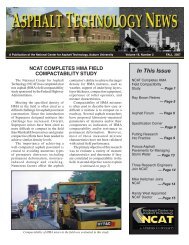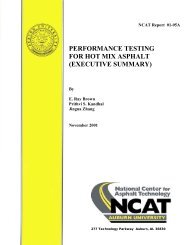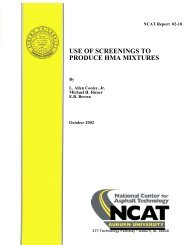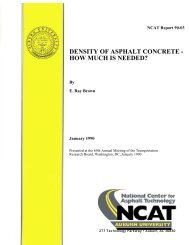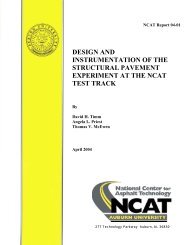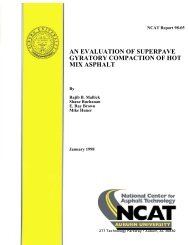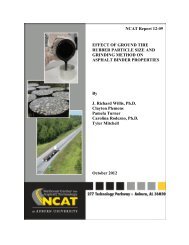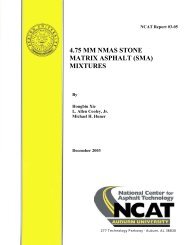A Review of Aggregate and Asphalt Mixture Specific Gravity ...
A Review of Aggregate and Asphalt Mixture Specific Gravity ...
A Review of Aggregate and Asphalt Mixture Specific Gravity ...
Create successful ePaper yourself
Turn your PDF publications into a flip-book with our unique Google optimized e-Paper software.
Both st<strong>and</strong>ard test procedures, including aggregate soaking time, cannot becompleted in one work day. All <strong>of</strong> the precision estimates for AASHTO T 85 <strong>and</strong> ASTM C127 from 1998through 2005 by the AMRL are much greater than those cited in the st<strong>and</strong>ards,<strong>and</strong> they vary significantly from year to year, which is presumed to be due to theuse <strong>of</strong> different aggregate sources in the pr<strong>of</strong>iciency sample program. The AggPlus system using the CoreLok device is commercially available as analternative method for determining G sb <strong>of</strong> coarse aggregate. Another device, theGilson Rapid Water Displacement, is being developed. Recent studies have evaluated the AggPlus system using the vacuum-seal deviceagainst the AASHTO T 85 procedure. The AggPlus system does not require thedetermination <strong>of</strong> SSD condition <strong>and</strong> soaking time. The AggPlus produced higherspecific gravity values that were significantly different (both statistically <strong>and</strong>practically) from those produced by AASHTO T 85. The difference was greaterfor highly absorptive coarse aggregate. Both methods had similar reproducibility.For the bulk specific gravity <strong>of</strong> fine aggregate, the review can be summarized below: In AASHTO T 84 <strong>and</strong> ASTM C128, the SSD condition <strong>of</strong> various fine aggregatesis not consistently determined using the cone <strong>and</strong> tamp technique. Both st<strong>and</strong>ard test methods, including aggregate soaking time, cannot becompleted in one work day. As with the st<strong>and</strong>ard test methods for bulk specific gravity <strong>of</strong> coarse aggregate,most <strong>of</strong> the precision estimates for AASHTO T 84 <strong>and</strong> ASTM C128 publishedannually on the AMRL website are greater than those cited in the st<strong>and</strong>ards, <strong>and</strong>they vary significantly from year to year. Several modifications have been made by states to improve the process <strong>of</strong>determining the SSD condition. However, all modifications still requiretechnician judgment, <strong>and</strong> the reproducibility improvement is not found in theliterature. Alternate methods for determining G sb <strong>of</strong> fine aggregate include the CoreLok,SSDetect, <strong>and</strong> Phunque. In addition, the Langley de-airing device can be usedwith AASHTO T 84. Recent studies have focused on the CoreLok <strong>and</strong> SSDetect devices. Both devicesdo not require the determination <strong>of</strong> SSD weight <strong>and</strong> soaking time. However, theG sb values determined using either procedure were significantly different fromthose produced using AASHTO T 84. Differences were greater for more angularfine aggregate with aggregate having higher dust contents. The SSDetect had thebest precision indices, then AASHTO T 84 <strong>and</strong> the CoreLok.The review <strong>of</strong> the maximum specific gravity <strong>of</strong> HMA mixtures can be summarized as: The ASTM multilaboratory precision for non-porous aggregate <strong>and</strong> theAASHTO/ASTM multilaboratory precision for porous aggregate appeared veryhigh, resulting in an allowable difference <strong>of</strong> up to 2% in between-laboratory airvoid values. The CoreLok <strong>and</strong> Pressure Meter procedures are alternatives for determining G mm .29




